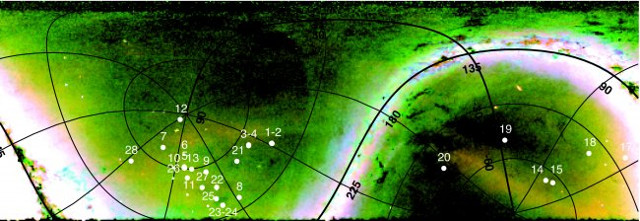
An article published in the journal “Astronomy & Astrophysics” describes a research on a group of red giant stars located in the halo surrounding the Milky Way. A team of astronomers led by Giuseppina Battaglia of the Istituto de Astrofísica de Canarias examined the composition of a 28-star sample discovering that the presence of some chemical elements is quite different from the halo’s innermost regions. The conclusion is that they were not born in our galaxy but in ancient dwarf galaxies that were absorbed by the Milky Way.
The Milky Way is surrounded by a huge halo of hot gases and, while most of its stars are located in the galactic disk, there’s a minority that is located in the halo. Halo stars may have orbits very different from those of the stars located in the galactic disk, an issue still under discussion. Halo stars may have been captured by our galaxy in the absorption of dwarf galaxies and to look for evidence the team led by Giuseppina Battaglia tried to examine their chemical characteristics.
In this research, 28 red giant stars that are very old because they’re in a very advanced phase of their life were examined with the technique of high resolution spectroscopy in the optical wavelengths. In essence, their light was broken into its various frequencies to look for the “signatures” left by the various elements that make up the stars that emitted it. The composition provides important information on the environment in which those stars were born.
Data of 100 hours of observations were used, coming in the Southern Hemisphere from ESO’sVery Large Telescope “Kueyen” (UT2) and from the Magellano Clay telescope, in Las Campana, and in the Northern Hemisphere by the Hobby Eberly Telescope, in Texas. The observations of the outer regions of the Milky Way are difficult due to the solar system’s position within the galaxy but the data used provided the information needed for this research.
The result of the analysis of those data showed that in the Milky Way halo’s outer regions there’s an abundance of some chemical elements quite different from the internal regions. Instead, the researchers found similarities with the chemical composition of stars in some dwarf galaxies in the “neighborhood” such as Sagittarius and the Large Magellanic Cloud.
The researchers concluded that in the Milky Way halo there are the chemical traces of ancient dwarf galaxies that at some point were absorbed by our galaxy. It’s no surprise because galactic mergers are well-known events and dwarf galaxies are often absorbed by larger ones, in this case the researchers found strong indications of this type of event in the Milky Way.

